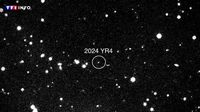In a surprising turn of events, the asteroid 2024 YR4, which had previously sparked fears of a potential collision with Earth, now presents a new concern: a 3.8% chance of impacting the Moon on December 22, 2032. This revelation comes from the latest data released by NASA on April 2, 2025, following observations from the James Webb Space Telescope and ground-based telescopes.
The probability of the asteroid hitting the Moon has increased significantly from 1.7% at the end of February 2025, raising eyebrows among astronomers and space enthusiasts alike. While there remains a 96.2% chance that the asteroid will miss the Moon, the prospect of a lunar impact has captured the attention of the scientific community.
Initially discovered on December 25, 2024, asteroid YR4 was classified as a potential threat to Earth, with risk assessments peaking at 3.1% in mid-February. However, as further observations were conducted, the likelihood of an Earth impact has since plummeted to a negligible 0.00011% as of April 3, 2025. This dramatic shift has alleviated concerns about the asteroid colliding with our planet.
Patrick Michel, an astrophysicist and director of research at the National Center for Scientific Research (CNRS) at the Côte d'Azur Observatory, reassured the public, stating, "No consequences for the Earth." He explained that while a collision with the Moon could eject material that might reach Earth, it would not pose a significant threat.
In the event of a lunar impact, the resulting crater is estimated to be between 600 meters and 1.2 kilometers in diameter, given that the asteroid is now believed to measure between 53 and 67 meters—about the size of a ten-story building. Michel further elaborated, "If we could observe this impact, it would be a fantastic experiment that would enhance our understanding of this process and verify our models."
The excitement surrounding a potential lunar collision is further amplified by the fact that no observations have been made of an object larger than 50 meters colliding with the Moon. Julia de Leon, an astronomer with the European Space Agency, echoed this sentiment, stating, "It would be incredible to observe a collision involving an object of this size, as we have never witnessed such an event before."
In addition to the scientific intrigue, the flash of impact from vaporized rock would be visible from Earth, even during daylight hours. Gareth Collins, a scientist at Imperial College London, noted that the visibility of such an event would provide a unique opportunity for public engagement and scientific observation.
As YR4 continues its journey through space, scientists remain vigilant, with new observations planned for late April or early May 2025. These upcoming analyses will further refine predictions regarding the asteroid's trajectory and potential for collision with the Moon. The European Space Agency has indicated that the probability of impact often fluctuates initially before stabilizing as uncertainties about the object's orbit are resolved.
The asteroid's journey has been closely monitored, especially after the early alarm bells rang in January 2025 when NASA first reported the potential for an Earth collision. The initial risk assessment of 1 in 32 was sufficient to mobilize the scientific community and prompt urgent observations using the James Webb Space Telescope.
The JWST's infrared analyses have provided more detailed data on 2024 YR4, revealing that its surface is rockier and colder than previously anticipated, suggesting a different composition than what was inferred from earlier ground-based observations. The asteroid's size has been adjusted from earlier estimates of 40 to 90 meters, providing a clearer picture of its potential impact.
Despite the initial panic surrounding 2024 YR4, the current outlook is one of cautious optimism. The possibility of a lunar impact, while still a concern, is viewed as an opportunity for scientific discovery rather than a catastrophic event. As scientists prepare for further observations, the excitement surrounding the potential for a lunar collision continues to grow.
In summary, while the asteroid 2024 YR4 poses no danger to Earth, its potential collision with the Moon offers a unique opportunity for scientists to study impact processes and lunar geology. As the date of the predicted impact approaches, the scientific community is eager to observe and learn from this celestial event, which could yield valuable insights into the history and evolution of our Moon.





